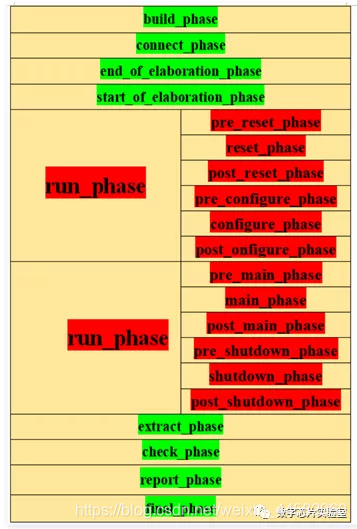UVM中,component的task phase是消耗仿真时间的,各个components的task phase之间需要完成同步。只有在所有components的相同task phase结束之后,才能进入下一个task phase。
UVM中通过objection mechanism中的raise/drop objection来控制phase的开始和停止。
当仿真器进入某个消耗时间的task phase时,首先会收集所有component**提起(raise)的objection,然后按顺序执行所有component各自的task phase,直到所有component提起的objection都被撤销(drop)**该phase的执行才算结束。
//driver中提起objection
task driver::main_phase(uvm_phase phase);
phase.raise_objection(this);
.....
phase.drop_objection(this);
endtask
//monitor中提起objection
task monitor::main_phase(uvm_phase phase);
phase.raise_objection(this);
.....
phase.drop_objection(this);
endtask
例如在上述代码中,仿真器收集driver和monitor各自提起的objection,按顺序执行省略代码,直到driver和monitor都撤销objection才算main_phase执行结束。
如果某个component的相应task phase没有被提起,则永远也不会执行消耗仿真时间的语句。同样,如果才task phase被提起后不被撤销,则该phase永远也不会结束。
在前面的代码中,main phase具有一个uvm_phase参数,这就是为具体实现raise/drop objection而设置的,这样每个component才能通过phase.raise_objection来提起相应的objection

UVM中的run_phase和其他task phase是并行关系,如果其他task phase中的objection被提起,run_phase也会执行,直到所有objection被撤销,run_phase才会结束。
下面通过几个例子展示objection的用法:
示例1:不加raise objection

class my_driver extends uvm_driver;
`uvm_component_utils(my_driver)
function new(string name = "my_driver", uvm_component parent =null);
super.new(name, parent);
`uvm_info("my_driver", "new is called", UVM_LOW);
endfunction
extern virtual task main_phase(uvm_phase phase);
endclass
task my_driver::main_phase(uvm_phase phase);
`uvm_info("my_driver", "main_phase is called",UVM_LOW);
@(posedge top_tb.clk);
`uvm_info("my_driver", "data is drived", UVM_LOW);
endtask
输出:
UVM_INFO my_driver.sv(8) @ 0: uvm_test_top[my_driver] new is called
UVM_INFO my_driver.sv(15) @ 0: uvm_test_top[my_driver] main_phase is called
没有输出"data is drived"
示例2:raise objection没有加在仿真时间0时刻
class my_driver extends uvm_driver;
`uvm_component_utils(my_driver)
function new(string name = "my_driver", uvm_component parent =null);
super.new(name, parent);
`uvm_info("my_driver", "new is called", UVM_LOW);
endfunction
extern virtual task main_phase(uvm_phase phase);
endclass
task my_driver::main_phase(uvm_phasephase);
@(posedge top_tb.clk);
phase.raise_objection(this);
`uvm_info("my_driver", "main_phase is called",UVM_LOW);
@(posedge top_tb.clk);
`uvm_info("my_driver", "data is drived", UVM_LOW);
phase.drop_objection(this);
endtask
输出:
UVM_INFO my_driver.sv(6) @ 0: uvm_test_top[my_driver] new is called
没有输出 "main_phase is called"和"data is drived"
示例3:不加drop objection
class my_driver extends uvm_driver;
`uvm_component_utils(my_driver)
function new(string name = "my_driver", uvm_component parent =null);
super.new(name, parent);
`uvm_info("my_driver", "new is called", UVM_LOW);
endfunction
extern virtual task main_phase(uvm_phase phase);
endclass
task my_driver::main_phase(uvm_phasephase);
phase.raise_objection(this);
`uvm_info("my_driver", "main_phase is called",UVM_LOW);
while(1) begin
@(posedge top_tb.clk);
`uvm_info("my_driver", "data is drived", UVM_LOW);
//phase.drop_objection(this);
end
endtask
输出:
UVM_INFO my_driver.sv(8) @ 0: uvm_test_top[my_driver] new is called
UVM_INFO my_driver.sv(15) @ 0: uvm_test_top[my_driver] main_phase is called
UVM_INFO my_driver.sv(16) @ 125840500000:uvm_test_top [my_driver] data is drived
UVM_INFO my_driver.sv(16) @ 125840700000:uvm_test_top [my_driver] data is drived
UVM_INFO my_driver.sv(16) @ 125840900000:uvm_test_top [my_driver] data is drived
…
UVM_INFO my_driver.sv(16) @ 125841100000:uvm_test_top [my_driver] data is drived
UVM_INFO my_driver.sv(16) @ 125841300000:uvm_test_top [my_driver] data is drived
UVM_INFO my_driver.sv(16) @ 125841500000:uvm_test_top [my_driver] data is drived
UVM_INFO my_driver.sv(16) @ 125841700000:uvm_test_top [my_driver] data is drived
陷入死循环
示例4:增加drop objection
class my_driver extends uvm_driver;
`uvm_component_utils(my_driver)
function new(string name = "my_driver", uvm_component parent =null);
super.new(name, parent);
`uvm_info("my_driver", "new is called", UVM_LOW);
endfunction
extern virtual task main_phase(uvm_phase phase);
endclass
task my_driver::main_phase(uvm_phasephase);
phase.raise_objection(this);
`uvm_info("my_driver", "main_phase is called",UVM_LOW);
while(1) begin
@(posedge top_tb.clk);
`uvm_info("my_driver", "data is drived", UVM_LOW);
phase.drop_objection(this);
end
endtask
输出:
UVM_INFO my_driver.sv(6) @ 0: uvm_test_top[my_driver] new is called
UVM_INFO my_driver.sv(13) @ 0: uvm_test_top[my_driver] main_phase is called
UVM_INFO my_driver.sv(16) @ 100000:uvm_test_top [my_driver] data is drived
正常输出
从上面几个示例可以看出,要想正确地实现对设计的仿真,必须合理地控制objection的提起和撤销,并且raise objection要发生在消耗时间的仿真语句之前。